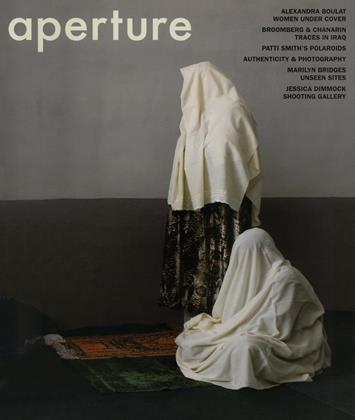PATTI SMITH LAND 250
ARTIST'S PROJECT
My camera is the Polaroid Land 250. Though sometimes idio syncratic, it is a good camera for me in my travels. I like the immediacy and the technical simplicity. Near/far. Dark/light. I take my camera with me from city to city. As I am a singer, I tour quite a bit and am fortunate to visit many interesting places. I take my pictures in natural or available light. If I can not choose the lighting, I do the best I can.
In England’s East Sussex, I visited Monk’s House, the former home of Leonard and Virginia Woolf. I was given access to her small bedroom, which is annexed to the house. Virginia’s Bed was covered with a white linen coverlet. I was taken with a vertical crease that crossed the horizontal eyelet lace. I was alone in the room with only two shots left in my camera. The light was very poor. I stood there for a very long time. I asked her to help me, and she did.
For a time I had a room of my own on MacDougal Street in New York City. It served as a butcher shop for decades and then as a Laundromat. I felt great pleasure in having this space to do my work uninterrupted. Before I lost the space I took my picture. It was difficult to take a Self-Portrait with my awkward camera. But I did my utmost to express the pride I felt in having my own studio.
In Charleville, France, the birthplace of the poet and adventurer Arthur Rimbaud, I had the privilege of photographing the few humble belongings of his that are in the local museum. His scarf, his utensils, and his Atlas. The strong fluorescent light overhead was very undesirable. It was a difficult, emotional experience. I was able to get only two shots I liked, one being of the geography book. It was large and I opened it to the title page, which was very beautiful. The edges were quite fragile and resembled an old cabbage, or the limp and rumpled hem of a child’s dress.
In the mid 1990s, after the deaths of my husband and my brother, I became somewhat fixated on the belongings of the deceased. Certain objects seemed to contain so much of their owner’s spirit. Nureyev’s Slippers was taken in 1995 in my room in Michigan. I placed them in a length of mosquito netting in the morning light. It is my homage to the great dancer who used the slippers to practice.
In Barcelona, I performed at the exquisite Palau de la Música —the Palace of Music. As I was I testing my sound, I noticed what appeared to be a white horse soaring high above stage right. I could just make it out. I took my camera and climbed the stairs. As I reached the top, I was obliged to crawl, as I suffer height sickness and sometimes experience vertigo. I was determined to reach the horse, which I did. It was carved in white plaster and jutted from the wall. I shot it and it was fine, but not what I wanted. A Winged Horse should be flying, should have a sense of motion. I finally got my picture, thanked the horse, crawled back down the stairs and resumed my post before the microphone.
In Rome, my friend Stefano and I visited the grave of the poet Gregory Corso. Gregory is buried at the feet of his beloved Percy Bysshe Shelley. I had one shot, and was about to take a photograph of Gregory’s headstone, but I had no sense of him being there. “He’s hanging out with Shelley,” I said. We stood before Shelley’s Grave and I took my shot. When I showed Stefano the picture, he pointed to the dancing light source and cried out: “Patti, it is Gregory!” And so it seems.
Most of the photographs I took in the 1960s and ’70s have been lost or destroyed. Occasionally I find one in an old book, such as this little picture of Robert Mapplethorpe at the Chelsea Hotel. It was a typical gesture: hand in pocket as he scrutinized his work. I still remember taking it. Robert entered photography through the Polaroid camera. He loved looking at his work as I do mine. Often I can be found sitting on my hotel floor, studying my pictures with the vigor and concentration of a young boy arranging and assessing his baseball cards.©
Patti Smith
 View Full Issue
View Full Issue
More From This Issue
-
 Witness
WitnessSilhouettes
Winter 2006 By Caroline Mangez -
 Dialogue
DialogueMarilyn Bridges Flights Over Ancient Anatolia
Winter 2006 By Gail Buckland -
 Work And Process
Work And ProcessThe Red House
Winter 2006 By David Campany -
 Work In Progress
Work In ProgressFriends With Money
Winter 2006 By Jori Finkel -
 Essay
EssayPhotographic Icons
Winter 2006 By Philip Gefter -
 Roads Less Traveled
Roads Less TraveledThe Ninth Floor
Winter 2006 By Joshua Mack












